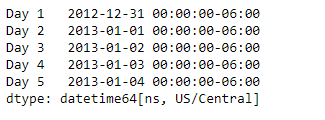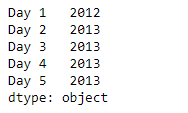Python| Pandas Series.dt.to_period
Series.dt 可用于以 datetimelike 的形式访问系列的值并返回多个属性。 Pandas Series.dt.to_period()函数以特定频率将给定 Series 对象的基础数据转换为 PeriodArray/Index。
Syntax: Series.dt.to_period(*args, **kwargs)
Parameter :
freq : string or Offset, optional
Returns : PeriodArray/Index
示例 #1:使用 Series.dt.to_period()函数将给定系列对象的基础数据以每周频率转换为索引。
Python3
# importing pandas as pd
import pandas as pd
# Creating the Series
sr = pd.Series(['2012-12-31', '2019-1-1 12:30', '2008-02-2 10:30',
'2010-1-1 09:25', '2019-12-31 00:00'])
# Creating the index
idx = ['Day 1', 'Day 2', 'Day 3', 'Day 4', 'Day 5']
# set the index
sr.index = idx
# Convert the underlying data to datetime
sr = pd.to_datetime(sr)
# Print the series
print(sr)Python3
# cast to target frequency
result = sr.dt.to_period(freq = 'W')
# print the result
print(result)Python3
# importing pandas as pd
import pandas as pd
# Creating the Series
sr = pd.Series(pd.date_range('2012-12-31 00:00', periods = 5, freq = 'D',
tz = 'US / Central'))
# Creating the index
idx = ['Day 1', 'Day 2', 'Day 3', 'Day 4', 'Day 5']
# set the index
sr.index = idx
# Print the series
print(sr)Python3
# cast to target frequency
result = sr.dt.to_period(freq = '2Y')
# print the result
print(result)输出 :

现在我们将使用 Series.dt.to_period()函数将给定系列对象的基础数据以每周频率转换为索引。
Python3
# cast to target frequency
result = sr.dt.to_period(freq = 'W')
# print the result
print(result)
输出 :

正如我们在输出中看到的,Series.dt.to_period()函数已成功地将数据转换为目标频率。
示例 #2:使用 Series.dt.to_period()函数以两年的频率将给定系列对象的基础数据转换为索引。
Python3
# importing pandas as pd
import pandas as pd
# Creating the Series
sr = pd.Series(pd.date_range('2012-12-31 00:00', periods = 5, freq = 'D',
tz = 'US / Central'))
# Creating the index
idx = ['Day 1', 'Day 2', 'Day 3', 'Day 4', 'Day 5']
# set the index
sr.index = idx
# Print the series
print(sr)
输出 :

现在我们将使用 Series.dt.to_period()函数将给定系列对象的基础数据以两年的频率转换为 Index。
Python3
# cast to target frequency
result = sr.dt.to_period(freq = '2Y')
# print the result
print(result)
输出 :

正如我们在输出中看到的,Series.dt.to_period()函数已成功地将数据转换为目标频率。